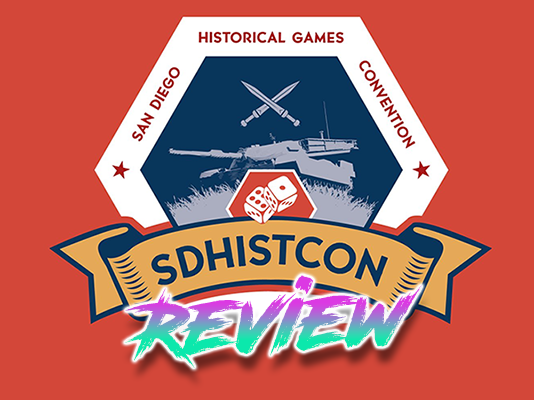I’ve been playing boardgames my whole life, but I’ve never been to a boardgame convention. Most of them are too far away, requiring me to take time off work and invest in expensive travel and lodging. It just hasn’t been in the cards. Since 2020, however, attending a con hasn’t been in the cards for anyone thanks to a global pandemic that has asked people to lock themselves down. This is when “virtual conventions” started to become a thing.
Virtual cons promised an opportunity to connect with gamers, play or demo some games, and experience the convention through a computer screen – without the need for travel or crowds. Before last week, I had already been to a few, including SPIEL.digital and Camp Capstone. Each had strengths and weaknesses, but none have felt much like I was connecting with people, and I’d become pretty skeptical of virtual cons.
That was before 2021’s SDHistCon Spring Deployment, a historical online gaming convention put together by Harold Buchanan and his team, which wrapped up this past Sunday.
I discovered a fascination with history in my 20’s, but historical gaming or wargaming is something I only really started exploring in last five to ten years. As I got deeper into this corner of the hobby, which is still relatively niche, I started talking to other wargamers and wargame designers online. It’s a fantastic, welcoming community of people who love to share their passions. Despite being new, I never felt ostracized. That said, whenever they got together at Consimworld Expo, or Weekend At The Warehouse, or the San Diego Historical Games Convention… I felt excluded merely by way of my own inability to attend.
However, for the cost of a $10 badge, SDHistCon let me through the virtual doors this weekend and gave me access to over 100 sessions with well known designers, up and coming designers, artists, and like-minded fans. I felt like Nick Carraway having finally been invited to one of Gatsby’s grand parties after watching them from afar for so long. Giddy and a bit overwhelmed.
Friday Highlights
On Friday it started with Volko Ruhnke’s first session (of three) for Nevsky, his first Levy & Campaign series game. He attempted to demo out the entire 1240-1242 Crusade On Novgorod campaign. We got to play along as a kind of communal demonstration. Though I had learned and played a few solo games of Nevsky a few months back, this session allowed me to pick up on a few key rules gaffs I had made. Volko was wonderfully patient with everyone, and his guidance on strategic choices was perfectly helpful. Nevsky is a beautiful game with a focus on recruiting lords and vassals, managing supply logistics, and strategically sacking enemy strongholds. I like how it creates an atmosphere of urgency, as you are always working against the clock.

After Nevsky, I watched a portion of Harold Buchanan’s interview with Ted Raicer, which was interesting as I don’t think I’ve ever encountered an interview with Ted before, though we’ve talked a bit on Twitter. Harold has a lovely, relaxed, PBS style approach to interviewing that I love. I also caught a bit of his interivew with Jason Matthews, who gave us a hint at his next game – a Napoleonic game that may or may not have the word “Struggle” in the title.
Next up, I watched Francisco Gradaille Vilar’s demo of his prototype of Plantagenet: Cousins’ War for England. This is a Levy & Campaign design that will attempt to cover the entire Wars Of The Roses. It is certainly evolved from Nevsky (the first Levy & Campaign game), with a new Influence currency that you use to muster lords and vassals. I will be keeping a close eye on this.
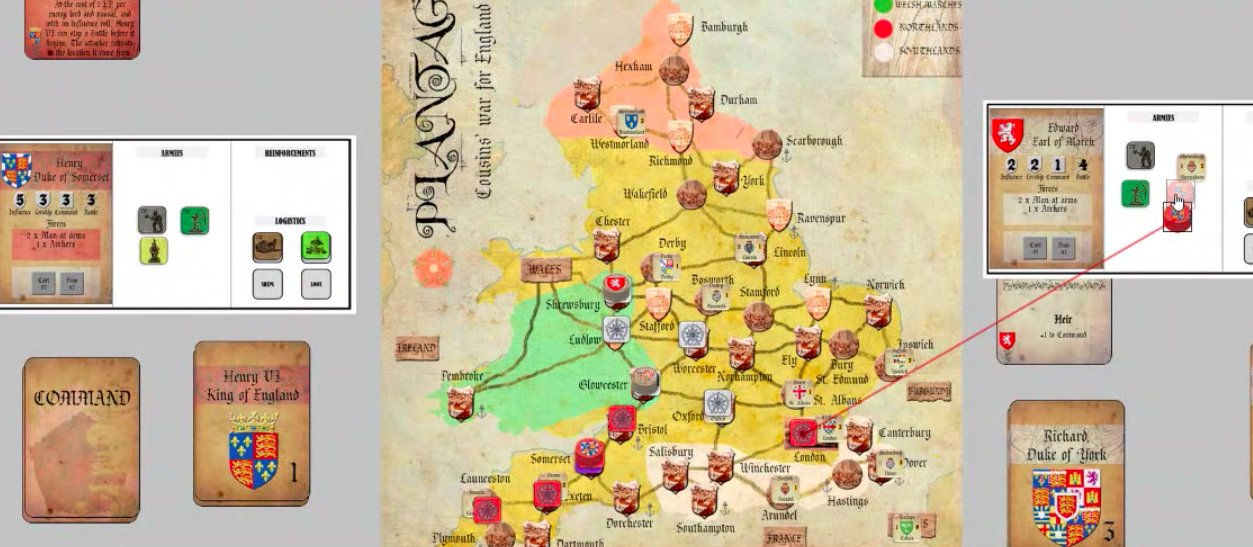
The Zenobia Awards event was another highlight, during which a small handful of unknown game designers got to show off their incredibly creative efforts. Subjects included the Marcos-era Philippines, the Taino Rebellion of 1511, Machu Picchu, and the first Palestinian Intifada. All in all, there are 48 participants in the Zenobia Awards working on developing diverse prototypes – many on topics or conflicts I’ve never even heard of. It’s brilliant. As someone who is working on his own first design, watching this process and seeing the support being given from professionals is really inspiring.

Saturday Highlights
Early on Saturday I got to sit in on a game of Bayonets & Tomahawks with designer and all around nice guy Marc Rodrigue. This game looks fantastic. I’ve already opened my copy and started in on the rulebook, but having Marc guide us through it was a wonderful primer to the game, which looks both easy to understand but also rich with decisions, as units compete for position and attempt to perform successful raids to accumulate victory points. It’s exciting and vibrant – plus, that beautiful board? Get out of town.

Subsequently, we had a fantastic Art Of Wargaming session in which Scott Mansfield interviewed Terry Leads, Nils Johannson, Marc Rodrigue, Richard Shako, and Jerry White. These folks are some of the best of the best when it comes to graphic design in historical gaming, so getting to listen to them chat about their experiences was enlightening, even if I missed the first half. UPDATE: Scott has now posted this on Youtube, here.
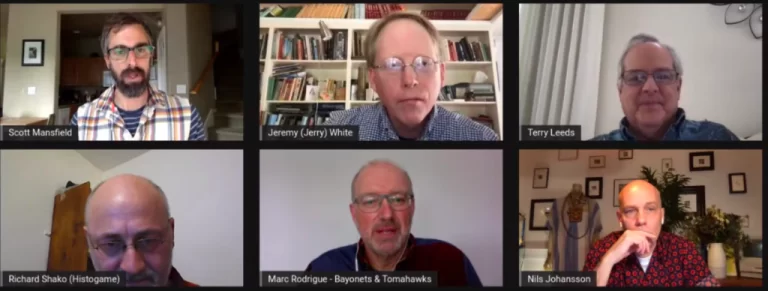
John Butterfield then got to unveil a brand new (to us) Chad Jensen game called Downfall. This is a title Chad had been working on for close to a decade before he passed away last year, and while much of it is complete, it is being finished by John and Kai Jensen. In a nutshell, it’s a WWII game for two players with one controlling the western allies and the other controlling the soviets. Lots of neat looking mechanisms and innovations here around action selection, and initiative.
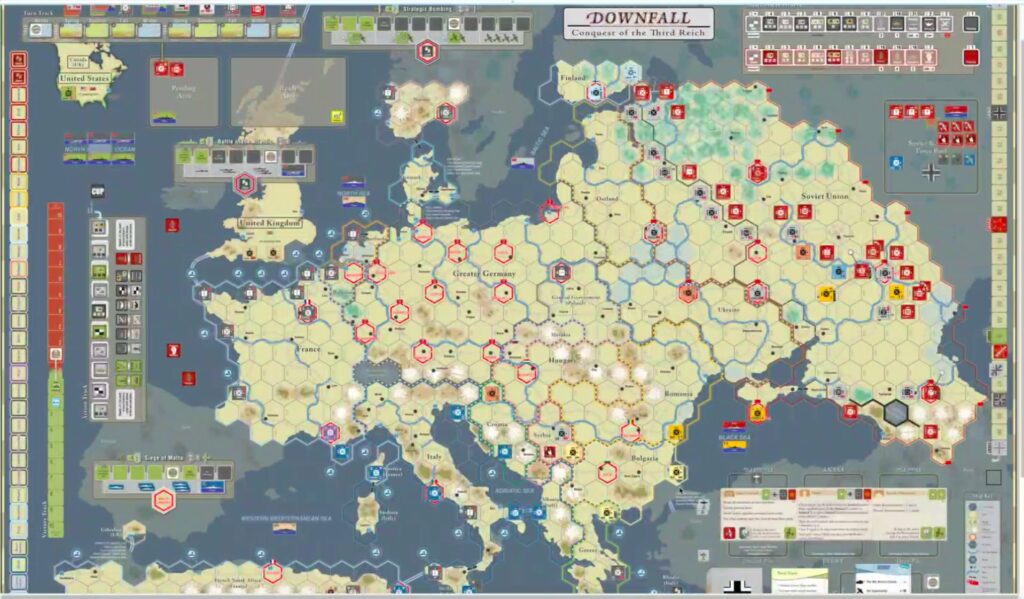
I capped off Saturday with GMT Night, where Gene Billingsley and the GMT crew talked about the state of the company (all quite positive, by the way) and designers got to talk about what they were working on for GMT.
Sunday Highlights
Sunday was a more relaxed day for me, during which I spent most of my time checking out the two games in GMT’s new Irregular Conflict Series (ICS). The first was Vijayanagara: The Deccan Empires of Medieval India, and A Gest Of Robin Hood: Insurrection in Nottinghamshire. Both of these look like terrific, COIN inspired games but in a more streamlined package. Vijayanagara is a 1-3 player game from Cory Graham, Mathieu Johnson, Aman Matthews, and Saverio Spagnolie. It’s set in 13-14th century India, with players taking on the role of either the Delhi Sultanate, the Bahmani Kingdom, or the Vijayanagara Empire as they rally amirs and rajas to their cause.
A Gest Of Robin Hood is from designer Frédéric Serval and is set in the world of Robin Hood as he patrols the forests around Nottingham, relieving the rich of their coin and returning it to the peasantry. It’s a really exciting looking game for two players where one controls Robin and the Merry Men, and the other controls the Sherriff of Nottingham and his Henchmen – struggling to subdue revolts in the shire. I found it very evocative of the period, from robbing carriages to royal inspections. Also… coins! This one went right on to my wantlist.

Finally, I got to spend a little time with David Johnson who demoed By Stealth And Sea from DVG, a game about Italian frogmen in WWII who sat atop torpedos and guided them straight into enemy vessels. This one looks challenging and immersive (no pun intended).
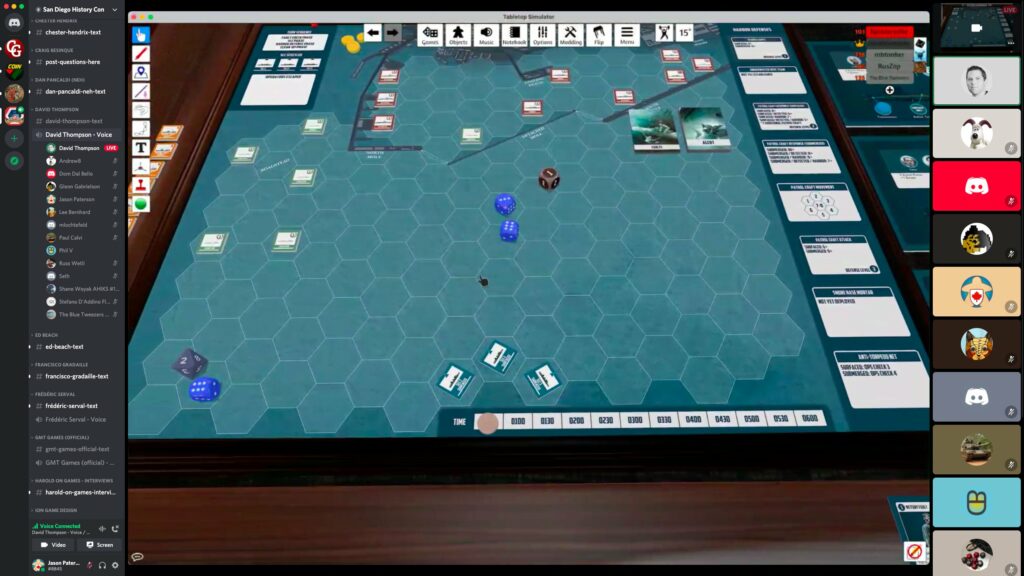
Round `Em Up
I need to really thank Harold and the whole gang for putting on a great show. It was smooth and fun and allowed me take part in something I haven’t been able to before. One of the big hurdles with something like this is anticipating how all the technology will work, and dealing with the varying level of savvy amongst presenters and attendees. Luckily, there was a small team of highly skilled and friendly volunteers helping out in this regard, and they were fantastic. Most games were shown off in Vassal or Tabletop Simulator and streamed via Discord, which also had voice and text chat rooms for every presenter. As an attendee, I found it easy to understand and about as interactive as you can get, which was in no small part due to some great presenters.
A question that came up a few times (and one I asked myself) was whether or not SDHistCon would continue to offer a virtual option once the in-person convention resumes. This is still up in the air officially, but I know they’re putting lots of thought into that. Given the amount of international interest (growing now thanks to efforts like the Zenobia Award) I wouldn’t be surprised if SDHistCon supplements their live gathering with an offset virtual gathering in the future.
If they do, I know I’ll be there.

